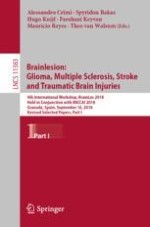2019 | OriginalPaper | Buchkapitel
Pathology Segmentation Using Distributional Differences to Images of Healthy Origin
verfasst von : Simon Andermatt, Antal Horváth, Simon Pezold, Philippe Cattin
Erschienen in: Brainlesion: Glioma, Multiple Sclerosis, Stroke and Traumatic Brain Injuries
Aktivieren Sie unsere intelligente Suche, um passende Fachinhalte oder Patente zu finden.
Wählen Sie Textabschnitte aus um mit Künstlicher Intelligenz passenden Patente zu finden. powered by
Markieren Sie Textabschnitte, um KI-gestützt weitere passende Inhalte zu finden. powered by
